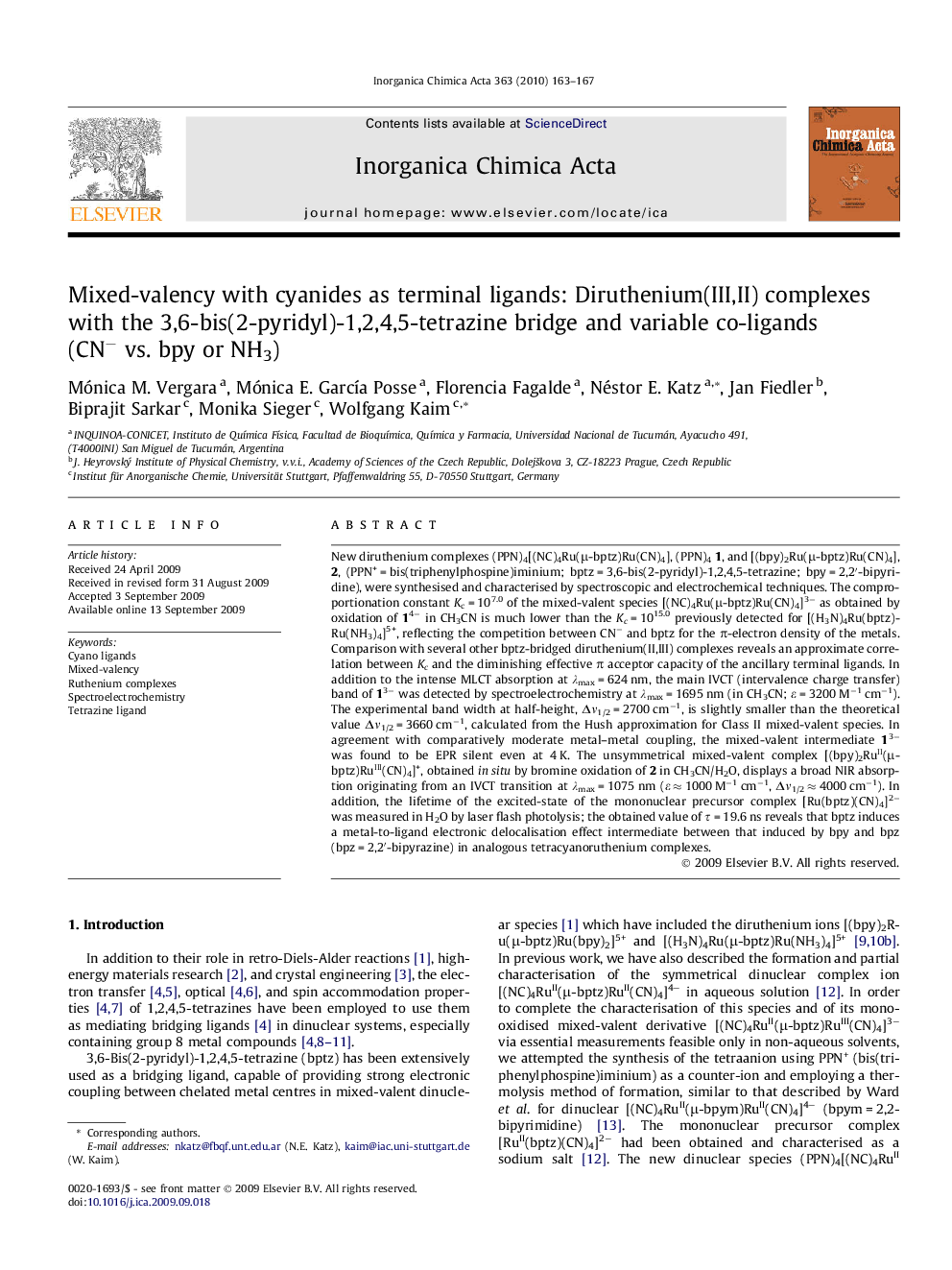| کد مقاله | کد نشریه | سال انتشار | مقاله انگلیسی | نسخه تمام متن |
|---|---|---|---|---|
| 1311309 | 975310 | 2010 | 5 صفحه PDF | دانلود رایگان |

New diruthenium complexes (PPN)4[(NC)4Ru(μ-bptz)Ru(CN)4], (PPN)41, and [(bpy)2Ru(μ-bptz)Ru(CN)4], 2, (PPN+ = bis(triphenylphospine)iminium; bptz = 3,6-bis(2-pyridyl)-1,2,4,5-tetrazine; bpy = 2,2′-bipyridine), were synthesised and characterised by spectroscopic and electrochemical techniques. The comproportionation constant Kc = 107.0 of the mixed-valent species [(NC)4Ru(μ-bptz)Ru(CN)4]3− as obtained by oxidation of 14− in CH3CN is much lower than the Kc = 1015.0 previously detected for [(H3N)4Ru(bptz)Ru(NH3)4]5+, reflecting the competition between CN− and bptz for the π-electron density of the metals. Comparison with several other bptz-bridged diruthenium(II,III) complexes reveals an approximate correlation between Kc and the diminishing effective π acceptor capacity of the ancillary terminal ligands. In addition to the intense MLCT absorption at λmax = 624 nm, the main IVCT (intervalence charge transfer) band of 13− was detected by spectroelectrochemistry at λmax = 1695 nm (in CH3CN; ε = 3200 M−1 cm−1). The experimental band width at half-height, Δν1/2 = 2700 cm−1, is slightly smaller than the theoretical value Δν1/2 = 3660 cm−1, calculated from the Hush approximation for Class II mixed-valent species. In agreement with comparatively moderate metal–metal coupling, the mixed-valent intermediate 13− was found to be EPR silent even at 4 K. The unsymmetrical mixed-valent complex [(bpy)2RuII(μ-bptz)RuIII(CN)4]+, obtained in situ by bromine oxidation of 2 in CH3CN/H2O, displays a broad NIR absorption originating from an IVCT transition at λmax = 1075 nm (ε ≈ 1000 M−1 cm−1, Δν1/2 ≈ 4000 cm−1). In addition, the lifetime of the excited-state of the mononuclear precursor complex [Ru(bptz)(CN)4]2− was measured in H2O by laser flash photolysis; the obtained value of τ = 19.6 ns reveals that bptz induces a metal-to-ligand electronic delocalisation effect intermediate between that induced by bpy and bpz (bpz = 2,2′-bipyrazine) in analogous tetracyanoruthenium complexes.
In spite of a strongly mediating tetrazine-containing bridge, the study of electrochemical and electronic coupling between tetracyanoruthenium moieties reveals attenuated metal–metal interaction as caused by the π acceptor effect of the peripheral CN– ligands.Figure optionsDownload as PowerPoint slide
Journal: Inorganica Chimica Acta - Volume 363, Issue 1, 4 January 2010, Pages 163–167